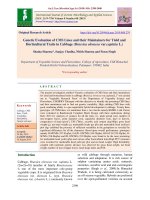Character association and partitioning of correlations of yield and its attributing traits in late sown barley (Hordeum vulgare L.)
Bạn đang xem bản rút gọn của tài liệu. Xem và tải ngay bản đầy đủ của tài liệu tại đây (294.42 KB, 7 trang )
Int.J.Curr.Microbiol.App.Sci (2018) 7(7): 2020-2026
International Journal of Current Microbiology and Applied Sciences
ISSN: 2319-7706 Volume 7 Number 07 (2018)
Journal homepage:
Original Research Article
/>
Character Association and Partitioning of Correlations of Yield and Its
Attributing Traits in Late Sown Barley (Hordeum vulgare L.)
Banoth Vinesh*, L.C. Prasad and Ravindra Prasad
Department of Genetics and Plant Breeding, Institute of Agricultural Sciences
Banaras Hindu University, Varanasi - 221005, India
Corresponding author
ABSTRACT
Keywords
Correlation, Path
analysis, Barley,
association
Article Info
Accepted:
15 June 2018
Available Online:
10 July 2018
The present study was carried out at Dept. of Genetics and Plant Breeding, BHU
during rabi of 2016-17 comprising of 101 barley genotypes. Association of yield and
its contributing traits was analyzed and these correlations were partitioned to have
clear understanding direct and indirect effects on the grain yield per plant under
terminal heat stress. Out of the 13 quantitative traits, grain yield per plant had shown
highly significant and positive correlation with effective tillers, stomatal conductivity,
and plant height grains per ear and 1000 grain weight which indicated strong
association of these traits with the yield. Through path coefficient analysis, grain per
ear revealed positive direct effect on the grain yield per plant while most the
correlation between these traits was contributed by indirect effects through stomatal
conductivity.
Introduction
Barley (Hordeum vulgare L.) is an ancient
cereal grain, which upon domestication has
evolved from largely a food grain to a feed
and malting grain (2, 16). It is fourth largest
cereal crop after maize, wheat and rice in the
world with a share of 7 per cent of the global
cereal production. In recent times, about twothirds of the barley crop has been used for
feed, one-third for malting and about 2 per
cent for food directly. It is a major source of
food for large population of cool and semiarid areas of the world, where wheat and other
cereals are less adapted. Barley is an annual
cereal grain crop that is consumed as a major
feed for the animals. Other than playing its
part as a major food crop, it is also used in
beverages and beers. It is available in a variety
of forms like whole barley, hulled barley,
pearled barley as well as barley flakes. Barley
contains about 75% carbohydrate, 9% protein
and 2% fat. In energy terms, each gram
provides about 3.3 calories. Barley grain is
rich in zinc (up to 50 ppm), iron (up to 60
ppm) and soluble fibers, and has a higher
content of Vitamins A and E than other major
cereals.
Overall India’s barley production was
estimated to be 17.81 lakh MT spread over an
area of 6.93 lakh ha for the year 2016-17 (1).
2020
Int.J.Curr.Microbiol.App.Sci (2018) 7(7): 2020-2026
Barley is an important winter cereal crop
grown in the northern plains of India
comprising the states of Uttar Pradesh, Bihar,
Haryana, Rajasthan, Punjab, Madhya Pradesh,
Himachal Pradesh and Uttarakhand that makes
about 80% of total acreage of India.
It is grown as a rainfed crop in poor marginal
soils due to its low input demand and lower
cost of cultivation. It occupies 0.46% of the
total cropped area, 0.62% of the food grains
and 0.76% of the cereals in the country.
Similarly it contributes 0.86% of the total
production of cereals and 0.81% of the food
grains in India. The most economically
desirable use of barley is for the production of
malt, the standards for which are quite
stringent. Barley that does not meet malt
quality standards often is utilized as feed for
livestock, although some barley is produced
solely as feed for animals, either as a grain or
hay forage.
Barley is also used in alternative settings such
as for ethanol production for bio-fuels and for
reducing algae in ponds and waterway. Even
though being an important crop, barley has
been neglected in our country due to priority
on wheat, rice and other cash crops. As a
result the harvested area, production and
productivity are falling down year by year.
A considerable number of grain production
studies on barley include statistical
correlations
between
agronomic
and
morphological characteristics and grain yield.
Although these correlations are helpful in
determining the principal components
influencing final grain yield, they provide an
incomplete representation of the relative
importance of direct and indirect influences on
the individual factors involved. It is known
that the grain yield in cereals is determined by
certain interrelated yield components. To
identify the dimension of the effect of each
yield component on grain yield is of
importance for use in defining selection
criteria for improving new varieties. Path
coefficient and correlation analyses are used
widely in many crop species by plant breeders
to
define the nature of
complex
interrelationships among yield. Correlation
coefficients measure the absolute value of the
correlation between variables in a given body
of data. A path coefficient measures the direct
influence of one variable upon another and
permits the separation of correlation
coefficient into components of direct and
indirect effects. Path coefficient analysis
specifies the cause and measures the relative
importance of the characters. This information
helps in formulating efficient scheme of
multiple trait selection, as it provides a means
of direct and indirect selection of component
characters. Therefore, the objective of this
study was to estimate the extent of association
between pairs of characters in genotypic and
phenotypic levels and thereby compare the
direct and indirect effects of the characters.
Yield is a complex character; its direct
improvement is difficult. Knowledge of
correlation studies help plant breeder to
ascertain the real components of yield and
provide an effective basis for selection. The
characters contributing significantly to yield
can be identified and could be used as an
alternate selection criterion in yield
improvement programme. The genotypic
correlation between characters provides a
reliable measure of genotypic association
between characters and helps to differentiate
the vital associations useful in breeding from
non-vital ones (8).
Materials and Methods
The present investigation was conducted at
Genetics and Plant Breeding, Research Farm,
Institute of Agricultural Sciences, Banaras
Hindu University, Varanasi (U.P.) during rabi,
2016-17. Geographically, Banaras Hindu
2021
Int.J.Curr.Microbiol.App.Sci (2018) 7(7): 2020-2026
University is situated between 25º18' N
latitude, 83º 03´E longitudes and at an altitude
of 128.93 meters above the mean sea level in
the North Gangetic plain of eastern part of
Uttar Pradesh. The experimental materials
comprised of 101 exotic and indigenous
genotypes which were maintained by BHU
under All India Co-ordinated Wheat and
Barley Improvement Project. These were laid
in Randomized Block Design with three
replications for the investigation. The sowing
date was delayed by 20 days than the
recommended date of sowing for the region to
effect the terminal heat stress. Each treatment
(genotype) was sown in line having 2.75 m
length. The row to row and plant to plant
distance of 25 cm and 10 cm, respectively was
followed. All the recommended agronomic
practices
for
respective
experimental
conditions were followed to raise a good
normal crops. Five competitive plants, in each
plot were randomly selected and tagged well
in advance for recording the observations.
Data were recorded on the following
characters viz., days to 50 per cent flowering,
days to maturity, number of effective
tillers/plant, number of grains/ear, spike length
with awns (cm), spike length without awns
(cm), stomatal conductivity (mmol m-2 s-1),
SPAD
values,
leaf
rolling,
proline
-1
concentration (µmol g ), 1000-grain weight
(gm) and grain yield/plant (gm). Correlation
coefficient was computed using formula given
by (10) and direct and indirect effects of yield
contributing factors were estimated through
path analysis technique (21); (6).
Results and Discussion
can be identified and could be used as an
alternate selection criterion in yield
improvement programme. The genotypic
correlation between characters provides a
reliable measure of genotypic association
between characters and helps to differentiate
the vital associations useful in breeding from
non-vital ones (8).
In the present investigation, leaf rolling had
evidenced a positive association with days to
50% flowering and SPAD while stomatal
conductivity had negative effect on leaf rolling
(Table 1). Similar reports were expressed by
(15) and (4).
Days to 50% flowering exhibited significant
positive affiliation with days to maturity, flag
leaf length, spike length without awns but had
negative association with 1000-grain weight,
grains per ear, stomatal conductivity and
effective tillers per plant. These findings were
reinforced by the earlier reports of (7) and
(12).
Plant height had positive and significant
association with effective tillers per plant,
stomatal conductivity. Spike length with and
without awns. This was in accordance with the
findings of (11) for plant height, number of
effective per plant, number of grains per ear
and 1000 grain weight.
1000-grain weight was positively associated
with effective tillers per plant, stomatal
conductivity, plant height while it was
negatively
associated
with
proline
conductivity. Reports of (18) were in
agreement with present findings.
Correlation studies
Yield is a complex character; its direct
improvement is difficult. Knowledge of
correlation studies help plant breeder to
ascertain the real components of yield and
provide an effective basis for selection. The
characters contributing significantly to yield
Grain yield per plant had shown highly
significant and positive correlation with
effective tillers, stomatal conductivity, plant
height grains per ear and 1000 grain weight
which indicated strong association of these
traits with the yield.
2022
Int.J.Curr.Microbiol.App.Sci (2018) 7(7): 2020-2026
Table.1 Correlation matrix of 14 quantitative traits in a diverse collection of 101 barley genotypes
Characte
r
DF
DM
FL
ET
SPAD
SC
PC
DF
DM
FL
ET
SPAD
SC
PC
SL
SL W/O
PH
LR
G/E
GW
GY
1.000
0
0.6974**
*
0.2383**
*
0.179*
*
0.2839**
*
0.2037**
*
0.0912
0.1194
*
0.3026**
*
-0.0243
0.1255*
0.212***
0.239***
0.1629**
1.0000
0.0848
0.0410
0.2201**
*
0.0729
0.0130
0.1437
*
0.3073**
*
0.2703**
*
-0.0107
0.0693
-0.0929
0.0907
1.0000
0.0547
0.1103
0.0799
0.1946**
*
0.0006
-0.0261
0.0577
0.0334
0.1595**
0.0042
0.1423*
1.0000
-0.0252
0.2843**
*
-0.0884
0.0655
0.0305
0.3328**
*
-0.0529
0.3060**
*
0.2882**
*
0.4171**
*
1.0000
-0.0604
0.1459*
0.1191
*
0.0621
-0.1051
0.1353*
-0.0657
-0.0398
-0.0613
1.0000
0.0583
0.0509
-0.0159
0.3315**
*
0.1596*
*
0.6308**
*
0.3461**
*
0.8116**
*
1.0000
0.0050
-0.0647
-0.1301*
0.0723
0.0532
0.1627**
0.0049
1.0000
0.3489**
*
0.1532**
0.0788
-0.0494
-0.0007
-0.0496
1.0000
0.2837**
*
0.0356
-0.0514
0.0586
0.0235
1.0000
-0.0626
0.3686**
*
0.3234**
*
0.4088**
*
1.0000
0.1678**
-0.0346
0.1588**
1.0000
0.1926**
*
0.7053**
*
1.0000
0.3388**
*
SL
SLW/O
PH
LR
G/E
GW
GY
1.0000
DF=Days to 50% flowering, FL=flag leaf length, ET=effective tillers/plant, SPAD, SC=stomatal conductivity, PC=proline concentration, SL=splike length with
awn, SLW/O=spike length without awn, PH=plant height/E=grain per ear, LR=Leaf rolling, GW=1000 grain yielded= days to maturity, GY =grain yield
2023
Int.J.Curr.Microbiol.App.Sci (2018) 7(7): 2020-2026
Table.2 Direct (Bold) and Indirect effects of 13 quantitative traits on grain yield per plant in a diverse collection of 101 barley
genotypes
Character
DF
DM
FL
ET
SPAD
SC
PC
SL
SL W/O
PH
LR
G/E
GW
DF
0.0541
0.0378
0.0129
-0.0097
0.0154
-0.0110
0.0049
0.0065
0.0164
-0.0013
0.0068
-0.0115
-0.0130
DM
-0.0131
-0.0188
-0.0016
0.0008
-0.0041
-0.0014
-0.0002
-0.0027
-0.0058
-0.0051
0.0002
-0.0013
0.0017
FL
0.0086
0.0031
0.0363
0.0020
0.0040
0.0029
0.0071
0.0000
-0.0009
0.0021
0.0012
0.0058
0.0002
ET
-0.0264
-0.0060
0.0081
0.1473
-0.0037
0.0419
-0.0130
0.0097
0.0045
0.0490
-0.0078
0.0451
0.0425
SPAD
-0.0013
-0.0010
-0.0005
0.0001
-0.0047
0.0003
-0.0007
-0.0006
-0.0003
0.0005
-0.0006
0.0003
0.0002
SC
-0.1166
0.0417
0.0457
0.1627
-0.0346
0.5723
0.0334
-0.0291
-0.0091
0.1897
-0.0914
0.3610
0.1980
PC
-0.0024
-0.0003
-0.0052
0.0024
-0.0039
-0.0016
-0.0267
0.0001
0.0017
0.0035
-0.0019
-0.0014
0.0043
SL
-0.0044
-0.0053
0.0000
-0.0024
-0.0044
0.0019
0.0002
-0.0365
-0.0127
-0.0056
-0.0029
0.0018
0.0000
S L W/o
0.0082
0.0084
-0.0007
0.0008
0.0017
-0.0004
-0.0018
0.0095
0.0272
0.0077
0.0010
-0.0014
0.0016
PH
-0.0013
0.0148
0.0032
0.0182
-0.0057
0.0181
-0.0071
0.0084
0.0155
0.0547
-0.0034
0.0201
0.0177
LR
-0.0015
0.0001
-0.0004
0.0006
-0.0016
0.0019
-0.0009
-0.0010
-0.0004
0.0008
-0.0121
0.0020
0.0004
G/E
-0.0592
0.0193
0.0444
0.0853
-0.0183
0.1758
0.0148
-0.0138
-0.0143
0.1027
-0.0468
0.2787
0.0537
GW
-0.0075
-0.0029
0.0001
0.0091
-0.0013
0.0109
-0.0051
0.0000
0.0018
0.0102
-0.0011
0.0061
0.0315
0.0049
-0.0496
0.0235
0.4088***
0.1588***
0.7053
0.3388***
GY
0.0907 0.1423***
0.4171
-0.0613 0.8116***
0.1629**
*
Significant at p<0.05; **Significant at p<0.01; ***Significant at p<0.001
R2 =0.754, Residual effect= 0.49
2024
Int.J.Curr.Microbiol.App.Sci (2018) 7(7): 2020-2026
These findings were in accordance with the
results reported by (9) and (20). While it
exhibited negative and significant correlation
with days to 50% flowering and leaf rolling
similar result was reported by (3). Therefore,
grain per ear, effective tillers per plant, plant
height, spike length with awn and 1000 grain
weight can be identified as major characters
contributing towards yield directly and
indirectly and selection based on these
characters are effective in developing high
yielding barley genotypes/varieties.
effect on grain yield per plant while it
contributed to most the negative correlation of
days to 50% flowering on grain yield per plant
through indirect effects. This was in accordance
with the findings of (5); (14). Effective tillers
per plant had significant positive effects on
yield per plant while it has considerable indirect
effects via stomatal conductivity which were
similar to the earlier findings of (20); (19). The
residual (R) effect was 0.49, therefore
remaining 50% of the yield was contributed by
traits which were not considered in this
experiment.
Path coefficient analysis
References
The correlation coefficient indicates the degree
of relationship between characters but it alone
does not give clear picture of measure of
association between yield and its components. It
is most important to know the direct and
indirect influences of yield components for
selecting suitable genotypes for improving the
yield. Selection for yield is more effective when
it is based on component characters which are
highly heritable and positively correlated with
yield. When more number of variables are
considered in correlation the association
becomes more complex and less obvious. The
path analysis is useful under such
circumstances. This gives a clear picture of the
direct and indirect effects of various traits on
yield. Therefore, present investigation, path
analysis was carried out to generate such
information of direct and indirect effects on
yield by its
Grain per ear revealed positive direct effect on
the grain yield per plant while most the
correlation between these two traits was
contributed by indirect effects via stomatal
conductivity (Table 2). This was in accordance
with the findings of (5); (14); (13).
Even though 1000-grain weight had positive
association with grain yield per plant most of
this correlation was contributed by indirect
effect via stomatal conductivity this report was
reinforced by the earlier findings of (17).
Stomatal conductivity had significant positive
2025
1. Anonymous (2017). Progress Report of
All India Coordinated Research Project
on Wheat & Barley 2016-17, Vol. VI.
Barley Network. ICAR-Indian Institute of
Wheat and Barley Research, Karnal,
India. P. 280.
2. Baik BK and SE Ullrich. (2008). Barley
for food: Characteristics, improvement,
and renewed interest. Journal of Cereal
Science 48: 233–42.
3. Bhutta, W.M., Tahira., Muhammad, I.
(2005). Path-coefficient analysis of some
quantitative characters in husked barley.
Cadero de pesquisaSerieBiologia, 17(1):
65-70.
4. Carpc, E.B., Celk, N. (2012). Correlation
and path coefficient analysis of grain
yield and yield components in two- rowed
of barley (Hordeum vulgareconvar.
distichon) varieties. Notulae Scientia
Biologicae,4 (2): 128-131.
5. Desheva, G. (2016). Correlation and pathcoefficient analysis of quantitative
characters in winter bread wheat
varieties.Trakia Journal of Sciences, 14
(1): 24-29.
6. Dewey, D. R., Lu, K. H. (1959).
Correlation and path coefficient analysis
components of crested wheat grass seed
production.
Journal of Agronomy and
Crop Scienc, 51: 515-518.
7. Drikvand, R., Samey, K., Hossinpor, T.
(2011). Path Coefficient Analysis in Hullless Barley under Rainfed Condition.
Int.J.Curr.Microbiol.App.Sci (2018) 7(7): 2020-2026
8.
9.
10.
11.
12.
13.
14.
Australian Journal of Basic and Applied
Sciences, 5 (12): 277-279.
Falconer, D. S. 1981. Introduction to
quantitative genetics. 2nd Edition. Oliver
and Boyd, Edinburg, London.
Hailu A, Alamerew S, Nigussie M,
Assefa E (2016) Correlation and Path
Coefficient Analysis of Yield and Yield
Associated Traits in Barley (Hordeum
vulgare L.) Germplasm. Adv Crop Sci
Tech 4: 216.
Johnson, H.W., Robinson, H.E. and
Comstock, R.F. (1955). Genotypic and
phenotypic correlations insoyabeans and
their implications in selection. Agron. J.
47: 447-483.
Kishore, R.L., Pandy, D.D., Varma, S.K.
(2000).Genetic variability and character
association in hull-less barley(Horeum
vulgare L.). Crop Research (Hissar), 19
(2): 241-244.
Kumar, M., Shekhawat, S. S. (2013).
Correlation and path coefficient studies in
barley (Hordeum vulgare L.) under dual
purpose condition. Electronic Journal of
Plant Breeding, 4 (4):1313-1318.
Mittal, V.P., Brar, K.S., Singh. P. (2009).
Interrelationships and path coefficient
analysis for yield and component
characters in barley [Hordeum vulgare
(L.)].
International
journal
of
Agricultural Sciences, 5 (1): 151-153.
Mohammad, Z., Marefat, G., Jafar, Z.,
Majid, K., and Babak. A. (2011).
Correlation Analysis and Path Analysis
for Yield and its Components in Hulless
Barley. Advances in Environmental
Biology, 5 (1): 123-126.
15. Mohsin, T., Khan, N. and Farzana.N.
(2009).
Heritability,
phenotypic
correlation and path coefficient studies for
some agronomic characters in synthetic
elite lines of wheat. Journal of Food,
Agriculture & Environment,7 (3&4): 278
- 282.
16. Pourkheirandish M and T Komatsuda.
(2007). The importance of barley genetics
and
demonstration
in
a
global
perspectives. Annals of Botany 100: 999–
1008.
17. Singh, J., Prasad, L. C., Madakemohekar
A. H., and Bornare S. S. (2014). Genetic
variability and character association in
diverse genotypes of barley (Hordeum
vulgare L.). The bioscan,9 (2): 759-761.
18. Singh, S. R. J., Yadav, H.S., Singh, S.M.
(2003). Assessment of yield contributing
characters in rainfed barley. Advance in
Plant Sciences, 16 (1): 325-327.
19. Srivastava, S., Anil, S., Sanjiv, K., Anil.
K. (2012). Correltion and path coefficient
studies for yield and yield contributing
traits in malt barley (Hodeum vulgare L.).
International Journal of Engineering &
Science Research, 2 (3/2):100-110.
20. Tofiq, S. E., Taban, N., Hama
Amin.,Suaad, M. S. A., Dana, A.
A.(2015). Correlation and path oefficient
analysis
of
grain
yield
and
yieldcomponents
in
some
barley
genotypes created by full diallel analysis
in sulaimani region for f2 generation.
International Journal of Plant, Animal
and Environmental Sciences, 5 (4): 76-79.
How to cite this article:
Banoth Vinesh, L.C. Prasad and Ravindra Prasad. 2018. Character Association and Partitioning of
Correlations of Yield and Its Attributing Traits in Late Sown Barley (Hordeum vulgare L.).
Int.J.Curr.Microbiol.App.Sci. 7(07): 2020-2026. doi: />
2026
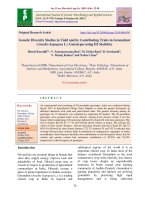
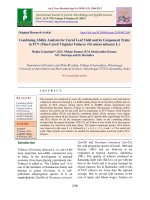
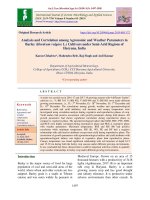
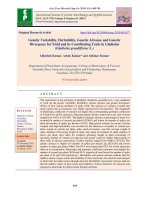
![Genetic variability studies in F2 segregating populations for yield and its component traits in Okra [Abelmoschu sesculentus (L.)Moench]](https://media.store123doc.com/images/document/2020_01/13/medium_nxs1578931693.jpg)




